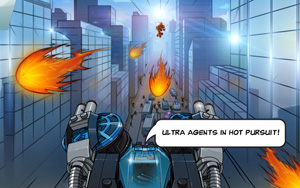 At school and at home, one of the most difficult challenges I face is in engaging reluctant readers. My son, who is a very capable reader, doesn't enjoy reading for pleasure. He tells me so every time I put a book in his hands—a conversation we have often. Every year, I have students who walk into my classroom already in the mindset that they don't like to read and never will. As an avid reader, my heart aches a little each time a child tells me they don't love books. As a teacher, I know that the best way for a student to be a really strong reader is to read—a lot!
At school and at home, one of the most difficult challenges I face is in engaging reluctant readers. My son, who is a very capable reader, doesn't enjoy reading for pleasure. He tells me so every time I put a book in his hands—a conversation we have often. Every year, I have students who walk into my classroom already in the mindset that they don't like to read and never will. As an avid reader, my heart aches a little each time a child tells me they don't love books. As a teacher, I know that the best way for a student to be a really strong reader is to read—a lot!
Of all the components of my job, helping kids find a love of reading is among the most important. So what can be done when a child just doesn't want to read? Finding just the right book or topic to suit a child's interests is the key. I have also found that graphic novels are excellent choices for reluctant readers. The text is broken up into more manageable pieces, the pictures appeal to visual learners and can aid in comprehension for struggling readers, and graphic novels have a “cool factor” that makes them in demand in both school and classroom libraries. There is no doubt that kids love comics and graphic novels, and we should be using that love to our advantage when it comes to getting kids to read.
Kids also love technology. When graphic novels are paired with digital readers or other mobile devices, it is a truly irresistible combination. Although interactive graphic novel apps have been a bit slow to take off, there are some available. One of the currently available interactive graphic novels is Lego Ultra Agents. This app combines a comic book reading experience with a classic game app to create an enhanced reading experience. Marvel's Avengers: Iron Man—Mark VII is another app with a similar set-up. It includes an interactive comic book enhanced by requiring the user to solve puzzles in order to unlock the next piece of the story as they read. These apps are really engaging and fun to use. They are great for helping kids feel that reading doesn't have to be a chore.
There are also quite a few other options for the use of digital graphic novels in the classroom. Many of the graphic novels available in digital formats are not interactive, but kids will still love being able to view them on their reader or tablet screen. Favorite series such as Percy Jackson & the Olympians, The Kane Chronicles, Diary of a Wimpy Kid, and Artemis Fowl can all be found as digital format graphic novels. For some reluctant readers, the novelty of reading on a mobile device may tempt them into giving reading for pleasure another chance and a selection of graphic novels on those devices may help students realize that engaging with a book can be an entertaining experience.
In addition, middle- and high-school students can also find their favorite book series as digital graphic novels. Beautiful Creatures and Maximum Ride, among others, have been released in Manga versions and digital formats. Even better, older students may also be interested in exploring the new, updated graphic novel versions of classic stories such as Macbeth and The Odyssey. These novels often have the original text, but have been adapted to a graphic novel format.
Aside from well-known books adapted to graphic novel format, there are a variety of apps that offer other comic and graphic novel options. Campfire Graphic Novels is an app offering a selection of comics based on people and events from history, which would be an excellent addition to a digital classroom library. Middle School Confidential is a set of graphic novels aimed at the upper elementary and middle school age group. The books are designed to help kids deal appropriately with tough situations and to reduce bullying, The Middle School Confidential website also offers a free teaching guide to allow for these books to be used with a whole class as a character education lesson.
The ways graphic novels can be utilized in the classroom are endless, from independent, self-selected reading to whole group lessons. The variety of stories available in the graphic novel format is continuing to expand, as parents and teachers see that kids like to read and engage with these books, even when they are hesitant to read traditional books. By combining the appeal of the graphic novel genre with the innovations found in new technologies, kids of all ages benefit and can find love and joy in engaging with literature.
 Lindsey Fuller is a sixth grade teacher in Decatur, IL. Her interests are classroom technology integration, literacy instruction, and Common Core curriculum development and implementation. You can read more from Lindsey on these topics at her blog, Tales of a 6th Grade Classroom.
Lindsey Fuller is a sixth grade teacher in Decatur, IL. Her interests are classroom technology integration, literacy instruction, and Common Core curriculum development and implementation. You can read more from Lindsey on these topics at her blog, Tales of a 6th Grade Classroom.